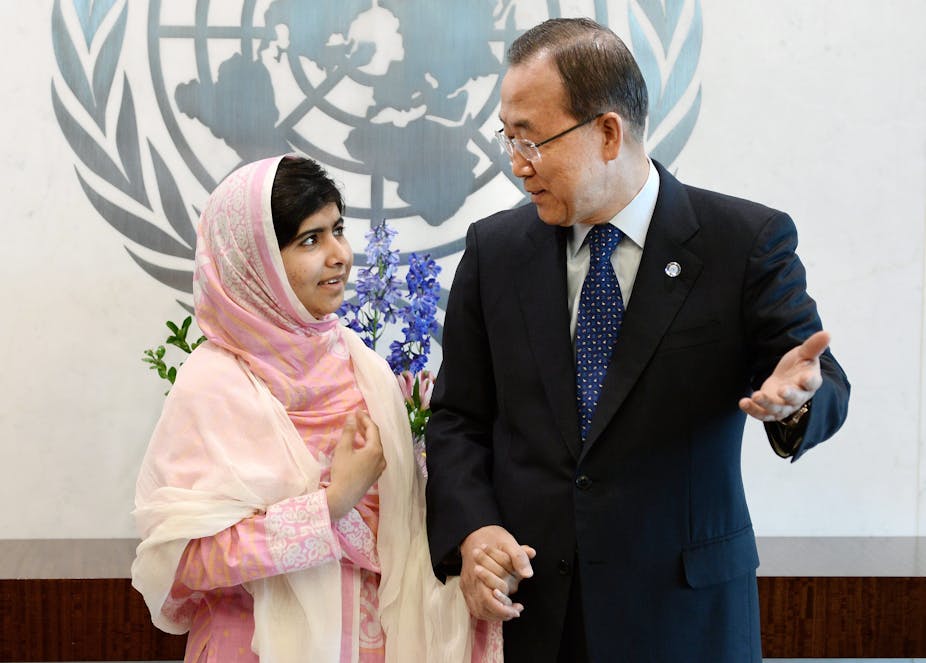Pakistani teenager Malala Yousafzai, now recovered from serious injuries after the Taliban shot her last year, delivered a defiant speech to the United Nations General Assembly over the weekend. She called on world leaders and governments to ensure free and compulsory education globally for every child, and to support the expansion of education opportunities for girls in the developing world.
UN Secretary General Ban Ki-moon declared July 12, 2013, (Malala’s birthday) as “Malala Day”, to renew commitment to children’s education globally. Gordon Brown, former British prime minister and now UN special envoy on global education, said on the occasion that: “Malala’s speech was just the start of a momentous push for change in the run up to 2015, to deal with the education emergency.”
Malala’s courage and her “education for all” message brings into focus the eight interrelated Millennium Development Goals adopted by the UN Millennium Declaration in 2000 to ensure that by 2015, children everywhere will be able to complete a full course of primary schooling.
But given the prevailing global economic situation and armed conflicts in many parts of the developing world, how realistic are these goals and what are the specific obstacles in achieving them?
Economic roadblocks
The UN’s Millennium Development Goals require a sustained partnership between developed and developing countries and a proactive approach by global financial institutions. All developed nations are committed to allocating 0.7% of their GNI (Gross National Income) to overseas development assistance – 70 cents in every $100. Only five countries have reached this target so far: Denmark, Luxembourg, the Netherlands, Norway and Sweden.
Few other countries, such as Britain, may reach the 0.7% target by 2015, but the overall contributions are nowhere close to the estimated target. Global economic recession and dwindling economies worldwide, especially in North America and Europe, have put the funding required to sustain the campaign for universal education in serious jeopardy.
In 2012-13, the Australian government committed A$5.2 billion in foreign aid, about 0.35% of GNI, or 35 cents in every A$100. Since 2007, the Australian government has made significant progress in increasing aid from 0.28 to 0.34% of GNI, but it is still far from desirable. This is only the first major roadblock.
The situation in the developing world is also far from ideal, so much so that it is difficult to even imagine that universal education will be achieved by the stated deadline.
Political roadblocks
The more significant obstruction is within countries where armed conflict and violence has disrupted normal life in every sense. The United Nations Educational, Scientific and Cultural Organisation’s (UNESCO) Education for All Global Monitoring report shows that half of the 57 million children deprived of school education live in conflict-affected countries.
Malala’s home country, Pakistan, has an appalling record on education and literacy rates. Taliban militants have targeted schools that they perceive as imparting “secular and Western” education. School teachers, girls and women trying to defy militant diktats have been attacked and brutally killed. Malala herself had a lucky escape.
Malala’s UN speech comes with the backdrop of a horrific suicide bomb attack at the Sardar Bahadur Khan University in the Pakistani town of Quetta on June 15 this year, which killed 14 female students and injured 19 others. It was carried out by a female suicide bomber, an unknown phenomenon some years ago.
This raises the question about the network of religious “madrassa” education, where children from poor families are indoctrinated to carry out suicide attacks. Several suicide bombers in recent months have been teenage children forced to embrace the bomb instead of the book. Yet global outrage is, so far, absent on this issue.
Roadblocks in schools
UNESCO considers Pakistan’s overall literacy rate as a mere 56%. Rural Pakistan has 70% illiteracy. This is an alarming picture in a region where even India and Sri Lanka have moved to 75% and 91% literacy rates respectively.
The recently announced provincial budget in Pakistan shows that provinces have increased their spending on education. Malala’s home province, Khyber Pakhtunkhwa (KP) - which is the most affected by the conflict with the Taliban - has declared an education emergency with Rs102.4 billion set aside for education. This constitutes almost 30% of KP’s budget allocation. But this may not make a substantial difference on the ground in a country where the development budget has never been fully utilised. Pakistani newspaper The Nation reports that in 2012-13, only half of the budget allocation was satisfactorily utilised.
Higher allocation of budget spending on education does not guarantee an effective implementation. Although educational infrastructural development is absolutely necessary in areas such as the Swat Valley (where schools have been destroyed) that does not become a priority. An overwhelming share of public expenditure on education is devoted to teachers’ salaries and other recurring expenses, with not much left for investing in new capacity.
A pessimist’s view might be that the imminent withdrawal of international troops from Afghanistan, will only embolden the Taliban in the region. Peace talks only provide legitimacy to the Taliban’s brutal and misogynistic politics.
Unless there is a strong political will within Afghanistan and Pakistan to address extremism and work for the development of the people and infrastructure, this conflict will only worsen. There is a very long, rough terrain to be traversed before Malala’s vision - “One child, one teacher, one book and one pen can change the world” - can become a reality.
2015 is too ambitious in the current scenario.

